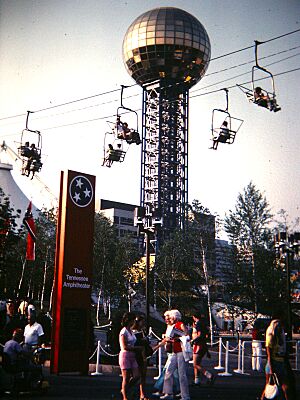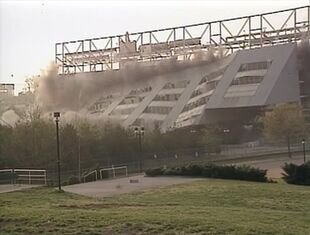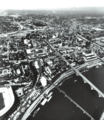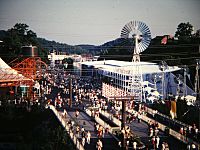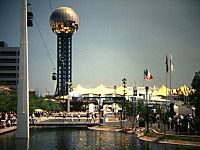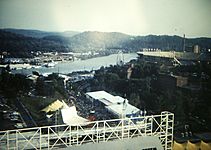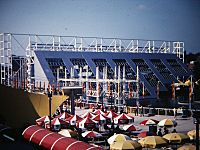1982 World's Fair facts for kids
Quick facts for kids 1982 Knoxville |
|
|---|---|
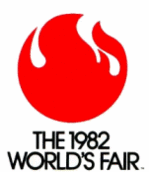
The 1982 World's Fair logo
|
|
| Overview | |
| BIE-class | Specialized exposition |
| Category | International specialized exposition |
| Name |
|
| Motto | Energy Turns the World |
| Building | Sunsphere, Tennessee Amphitheater |
| Area | 69 acres (28 ha) |
| Invention(s) |
|
| Visitors | 11,127,786 |
| Organized by |
|
| Participant(s) | |
| Countries | 22 |
| Business | More than 50 |
| Location | |
| Country | United States |
| City | Knoxville |
| Venue | World's Fair Park |
| Coordinates | 35°57′43″N 83°55′26″W / 35.962°N 83.924°W |
| Timeline | |
| Bidding | 1975 |
| Awarded | 1980 |
| Opening | May 1, 1982 |
| Closure | October 31, 1982 |
| Specialized expositions | |
| Previous | Expo 81 in Plovdiv |
| Next | 1984 Louisiana World Exposition in New Orleans |
| Universal expositions | |
| Previous | Expo '70 in Osaka |
| Next | Seville Expo '92 in Seville |
| Horticultural expositions | |
| Previous | Floralies Internationales de Montréal in Montreal |
| Next | Internationale Gartenbauaustellung 83 in Munich |
| Simultaneous | |
| Horticultural (AIPH) | Floriade 1982 |
The 1982 World's Fair, also known as the Knoxville International Energy Exposition or Expo '82, was a big international event. It took place in Knoxville, Tennessee, in the United States. The fair focused on energy and how we make electricity. Its main idea was Energy Turns the World. This event was officially recognized as a "World's Fair" by a group called the Bureau International des Expositions (BIE).
The fair opened on May 1, 1982, and closed on October 31, 1982. Over 11 million people visited it! Many countries participated, including Australia, Canada, China, France, Japan, the United Kingdom, and the United States. This was the second World's Fair in Tennessee. The first was in 1897 in Nashville.
The fair was built on a 70-acre site between Downtown Knoxville and the University of Tennessee. This area used to be an old railroad yard. Workers tore down most of the yard, but they kept one rail line. The old train station became a restaurant for the fair. The Sunsphere, a 266-foot tall steel tower with a gold globe on top, was the main symbol of the fair. Today, the Sunsphere is still a famous landmark in Knoxville.
Contents
How the Fair Started
The idea for a World's Fair in Knoxville came from local business leaders. They visited a fair in Spokane, Washington, in 1974. They thought Knoxville, with its links to energy research, would be a great place for an energy-themed fair. Knoxville is home to the Tennessee Valley Authority (TVA) and Oak Ridge National Laboratory (ORNL).
Knoxville's mayor chose a local banker, Jake Butcher, to lead the planning. Some people, both locally and nationally, doubted if Knoxville could host such a big event. The Wall Street Journal even called it a "scruffy little city." This led to Knoxville sometimes being called the "Scruffy City."
Many politicians and business people supported the fair. The U.S. federal government provided about $44 million in funding. The state of Tennessee gave $3 million, and Knoxville's city government approved nearly $12 million. There was also a lot of money spent to improve roads around Knoxville for the fair.
Building the Fairgrounds
The fair was built on a 70-acre site that was once an old railroad yard. This area was cleared to make space for country pavilions, the Tennessee Amphitheater, and the Sunsphere. The old L&N train station was turned into a restaurant and offices.
South of the main fair site, near the University of Tennessee, was the fair's midway. This area had rides, including the Great Wheel, which was the tallest Ferris wheel in the world at the time. A special gondola system helped visitors travel between the exhibits and the midway.
The Sunsphere was designed by a Knoxville architecture firm. Construction for the fair began in 1980.
Many countries agreed to participate, including nations from Western Europe, Australia, Mexico, Japan, and China. China's involvement was very important because it was one of their first big international events since 1904. In total, 22 nations participated in the 1982 World's Fair.
What Happened at the Fair
Opening Day Excitement
The 1982 World's Fair opened on May 1, 1982, with a huge crowd of 87,000 people. The theme was "Energy Turns the World." President Ronald Reagan came to officially open the fair. A famous TV personality, Dinah Shore, hosted the opening ceremony.
Visitors and Exhibits
The fair attracted over 11 million visitors from all over the world. This made it one of the most popular World's Fairs in U.S. history. The fair made a small profit, but the city of Knoxville was left with a debt of $46 million. This debt was fully paid off in May 2007.
Twenty-two nations, seven U.S. states, and over 50 companies had exhibits. These exhibits focused on energy, new ideas, technology, and how to live in a way that protects the planet.
Some interesting exhibits included:
- Peru showed a real mummy that was studied at the fair.
- Egypt displayed ancient artifacts worth over $30 million.
- Hungary, the home of the Rubik's Cube, sent the world's largest Rubik's Cube. It had rotating squares at the entrance to its pavilion. This giant Rubik's Cube is still on display in World's Fair Park today.
- Every night, a 10-minute fireworks show lit up the sky over Knoxville.
Fun Entertainment
Many famous artists and musicians performed at the Tennessee Amphitheater and other places. These included Bob Hope, Johnny Cash, Chet Atkins, and Glen Campbell.
Cool New Inventions
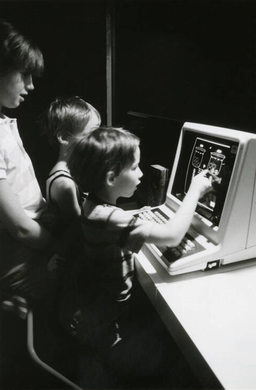
The 1982 World's Fair was a place to see many new inventions and ideas. Most of these were about energy, technology, and living sustainably.
- Touchscreen technology was shown by a physicist from Oak Ridge National Laboratory. Visitors could try out computers with touch screens.
- Coca-Cola Cherry made its debut! Visitors tasted different flavored Cokes, and cherry was the most popular. Coca-Cola started selling Cherry Coke in 1985 because of its success at the fair.
- The idea of pay at the pump for gas was shown by Texaco.
- An early version of the cordless telephone was introduced.
- Ford Motor Company showed a Lincoln Town Car with a built-in car phone. They also had a concept car that used alternative fuel.
- One-hour photo processing was introduced by Kodak.
- Exhibits showed geodesic dome housing and homes powered by solar power. These promoted sustainable living and energy saving.
- The fast-food chain Petro's Chili & Chips started at the fair.
Special Events
The Pittsburgh Steelers and New England Patriots played a preseason football game at Neyland Stadium. The Boston Celtics and Philadelphia 76ers also played an NBA exhibition game. The University of Tennessee used its dorms to house nearly 60,000 visitors during the fair.
Challenges Faced
Booking rooms for the fair was tricky. Hotels and other places could not take reservations directly. A central office handled all bookings, but it had problems.
A bank connected to one of the fair's main organizers, Jake Butcher, failed shortly after the fair closed. This led to questions about how the fair was financed.
What Remains Today
The fair's theme, "Energy Turns the World," is still important to Knoxville's economy. Energy-related jobs and businesses continue to grow there.
The U.S. Pavilion was later used as a soccer arena. However, it had structural problems and was torn down in 1991. The area became a parking lot.
The sites of other pavilions were redeveloped. The Japanese Pavilion became the new home for the Knoxville Museum of Art in 1990. Many areas of the fairgrounds were given to the University of Tennessee for campus growth and parking.
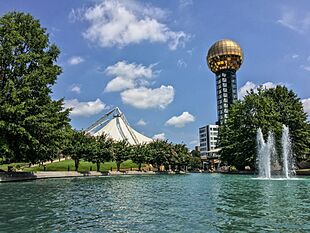
By 1996, many plans to redevelop World's Fair Park had failed. In 2000, the park closed for two years to build the Knoxville Convention Center.
The Tennessee Amphitheater is the only other original structure from the fair that still stands. It was renovated and reopened in 2007. It is now considered one of the top architectural works in East Tennessee.
In 2002, World's Fair Park reopened for events and concerts. An Independence Day celebration with fireworks and a free concert by the Knoxville Symphony Orchestra happens there every year. In May 2007, the East Tennessee Historical Society (ETHS) had an exhibit for the fair's 25th anniversary. The Sunsphere's observation deck also reopened after renovations.
In 2022, the ETHS and the University of Tennessee held exhibits for the fair's 40th anniversary. A big celebration festival also took place in May 2022.
Fun Collectibles
Many items were made for the 1982 World's Fair, like cups, plates, and belt buckles.
- Video Game Tokens: The fair had an arcade area with special tokens. There were seven different tokens, each showing a popular video game like Pac-Man, Donkey Kong, and Space Invaders.
- World's Fair Beer: A special "World's Fair Beer" was sold in nine different colored cans. Many people bought the cans as souvenirs, hoping they would become rare collectibles. For the fair's 35th anniversary in 2017, the beer was brought back for a limited time.
Images for kids
-
Japanese pavilion with artificial intelligence programmed "Painting Robot"
See also
 In Spanish: Exposición Internacional de Knoxville (1982) para niños
In Spanish: Exposición Internacional de Knoxville (1982) para niños
- List of world's fairs
- National Conservation Exposition


